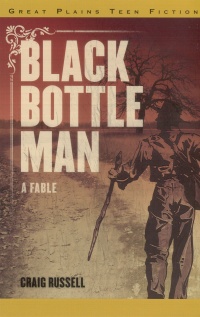| ________________
CM . . .
. Volume XVI Number 40. . . .June 18, 2010
excerpt:
Craig Russell’s fable tells the story of Rembrandt, who, at ninety-years old in 2007, has been on the road since Satan, also known as The Black Bottle Man, struck up a deal with his family in 1927. Desperate for children of their own, Rembrandt’s two aunts are ecstatic when they receive a package in the mail from Montreal containing a mysterious black bottle and instructions intended to help them conceive babies—black magic. Despite fierce warnings from Rembrandt’s parents and their own husbands to steer clear of the bottle and its contents, Aunt Annie and Aunt Emma follow its instructions and soon find themselves heavy with children and at odds with the rest of their family. Five weeks later, Satan arrives at their home of Three Farms looking for payment. His price? The souls of Annie and Emma when they die in exchange for two healthy, happy babies. Rembrandt’s Pa and Uncle Thompson counter the offer, stipulating that, if they can’t find a Champion in their lifetime to beat Satan, then Satan can take their souls as well. Satan agrees on the condition that the men must move every 12 days or else Satan will ensure something makes them move. And Rembrandt at aged 10 must go with them. Russell’s tale follows Rembrandt, Pa, and Uncle Thompson, who, traveling as hobos, cross the continent in search of a Champion to fight the Devil and to secure their souls. They never tarry for more than 12 days for, when they do, disaster strikes. Unable to make a stable home or secure permanent jobs, the men soon learn the ways of drifters and the magic inherent in using hobo signs. By 1932, Rembrandt is on his own at the age of 15—both Pa and Uncle Thompson dead. He meets the love of his life, Leona, at age 16 in Oklahoma, but he must keep moving. There are only so many homes that will host him for 12 days each before he is too far away to travel regularly to see Leona. The story ebbs and flows through time—depicting Rembrandt in the late 1920s, the dust-bowl depression-era days of the 1930s, and in 2007 as he floats from one Salvation Army to another—forever seeking out the Champion who will beat The Black Bottle Man and finish this gristly pact. One part travel narrative, one part spiritual fable, one part historical fiction, and one part adventure story—this tragic tale pulls readers in with its strong voice, richly depicted setting, and chilling confrontations with a shape-shifting Satan. Russell weaves magic into the narrative. You can feel the prairie dust stinging your eyes, smell the judgment of strangers, and hear the train as it rumbles along the track carrying readers to their next destination. Balanced with the story of Rembrandt as he travels across North America with his Pa and Uncle Thompson every 12 days from 1928 onwards is the story of Gail in 2007. Gail lives on the streets. She has a loving husband, Raymond, and a loving mother, Louise, who drop dinner off at her cardboard box every evening. Gail used to be a teacher until the day her classroom was held hostage by a gunman and she fell in love with him. Wracked by grief at his death, guilt for the child he killed, and an obsessive-compulsive tendency to count 3-5-9 and mark the sidewalk with chalk in an effort to keep all children safe, Gail leaves home to live alone on the streets as she believes herself past salvation. Russell does an expert job of juxtaposing the past and the present and of weaving the storylines together until the characters meet in an uplifting encounter that will save them both—reuniting them with their loves and lives long lost. Highly Recommended. Meghan Radomske is a student in the Master of Library and Information Studies Program at the University of British Columbia and the Writing & Book Camp Coordinator at Vancouver Public Library.
To comment
on this title or this review, send mail to cm@umanitoba.ca.
Copyright © the Manitoba Library Association. Reproduction for personal
use is permitted only if this copyright notice is maintained. Any
other reproduction is prohibited without permission.
NEXT REVIEW | TABLE OF CONTENTS FOR THIS ISSUE
- June 18, 2010.
AUTHORS
| TITLES|
MEDIA REVIEWS |
PROFILES |
BACK ISSUES |
SEARCH |
CMARCHIVE |
HOME
|
